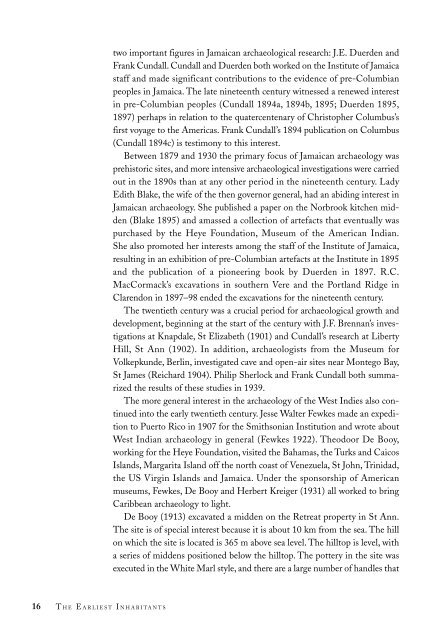The Earliest Inhabitants: The Dynamics of the Jamaican Taino
by Lesley-Gail Atkinson
by Lesley-Gail Atkinson
You also want an ePaper? Increase the reach of your titles
YUMPU automatically turns print PDFs into web optimized ePapers that Google loves.
16 T HE E ARLIEST I NHABITANTS<br />
two important figures in <strong>Jamaican</strong> archaeological research: J.E. Duerden and<br />
Frank Cundall. Cundall and Duerden both worked on <strong>the</strong> Institute <strong>of</strong> Jamaica<br />
staff and made significant contributions to <strong>the</strong> evidence <strong>of</strong> pre-Columbian<br />
peoples in Jamaica. <strong>The</strong> late nineteenth century witnessed a renewed interest<br />
in pre-Columbian peoples (Cundall 1894a, 1894b, 1895; Duerden 1895,<br />
1897) perhaps in relation to <strong>the</strong> quatercentenary <strong>of</strong> Christopher Columbus’s<br />
first voyage to <strong>the</strong> Americas. Frank Cundall’s 1894 publication on Columbus<br />
(Cundall 1894c) is testimony to this interest.<br />
Between 1879 and 1930 <strong>the</strong> primary focus <strong>of</strong> <strong>Jamaican</strong> archaeology was<br />
prehistoric sites, and more intensive archaeological investigations were carried<br />
out in <strong>the</strong> 1890s than at any o<strong>the</strong>r period in <strong>the</strong> nineteenth century. Lady<br />
Edith Blake, <strong>the</strong> wife <strong>of</strong> <strong>the</strong> <strong>the</strong>n governor general, had an abiding interest in<br />
<strong>Jamaican</strong> archaeology. She published a paper on <strong>the</strong> Norbrook kitchen midden<br />
(Blake 1895) and amassed a collection <strong>of</strong> artefacts that eventually was<br />
purchased by <strong>the</strong> Heye Foundation, Museum <strong>of</strong> <strong>the</strong> American Indian.<br />
She also promoted her interests among <strong>the</strong> staff <strong>of</strong> <strong>the</strong> Institute <strong>of</strong> Jamaica,<br />
resulting in an exhibition <strong>of</strong> pre-Columbian artefacts at <strong>the</strong> Institute in 1895<br />
and <strong>the</strong> publication <strong>of</strong> a pioneering book by Duerden in 1897. R.C.<br />
MacCormack’s excavations in sou<strong>the</strong>rn Vere and <strong>the</strong> Portland Ridge in<br />
Clarendon in 1897–98 ended <strong>the</strong> excavations for <strong>the</strong> nineteenth century.<br />
<strong>The</strong> twentieth century was a crucial period for archaeological growth and<br />
development, beginning at <strong>the</strong> start <strong>of</strong> <strong>the</strong> century with J.F. Brennan’s investigations<br />
at Knapdale, St Elizabeth (1901) and Cundall’s research at Liberty<br />
Hill, St Ann (1902). In addition, archaeologists from <strong>the</strong> Museum for<br />
Volkepkunde, Berlin, investigated cave and open-air sites near Montego Bay,<br />
St James (Reichard 1904). Philip Sherlock and Frank Cundall both summarized<br />
<strong>the</strong> results <strong>of</strong> <strong>the</strong>se studies in 1939.<br />
<strong>The</strong> more general interest in <strong>the</strong> archaeology <strong>of</strong> <strong>the</strong> West Indies also continued<br />
into <strong>the</strong> early twentieth century. Jesse Walter Fewkes made an expedition<br />
to Puerto Rico in 1907 for <strong>the</strong> Smithsonian Institution and wrote about<br />
West Indian archaeology in general (Fewkes 1922). <strong>The</strong>odoor De Booy,<br />
working for <strong>the</strong> Heye Foundation, visited <strong>the</strong> Bahamas, <strong>the</strong> Turks and Caicos<br />
Islands, Margarita Island <strong>of</strong>f <strong>the</strong> north coast <strong>of</strong> Venezuela, St John, Trinidad,<br />
<strong>the</strong> US Virgin Islands and Jamaica. Under <strong>the</strong> sponsorship <strong>of</strong> American<br />
museums, Fewkes, De Booy and Herbert Kreiger (1931) all worked to bring<br />
Caribbean archaeology to light.<br />
De Booy (1913) excavated a midden on <strong>the</strong> Retreat property in St Ann.<br />
<strong>The</strong> site is <strong>of</strong> special interest because it is about 10 km from <strong>the</strong> sea. <strong>The</strong> hill<br />
on which <strong>the</strong> site is located is 365 m above sea level. <strong>The</strong> hilltop is level, with<br />
a series <strong>of</strong> middens positioned below <strong>the</strong> hilltop. <strong>The</strong> pottery in <strong>the</strong> site was<br />
executed in <strong>the</strong> White Marl style, and <strong>the</strong>re are a large number <strong>of</strong> handles that


















